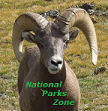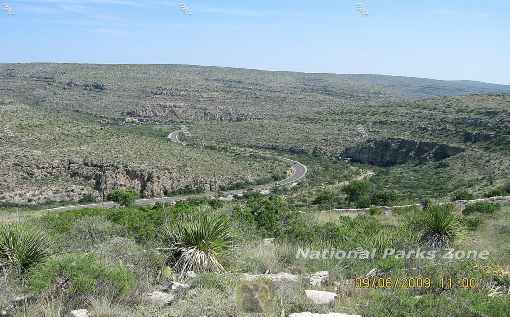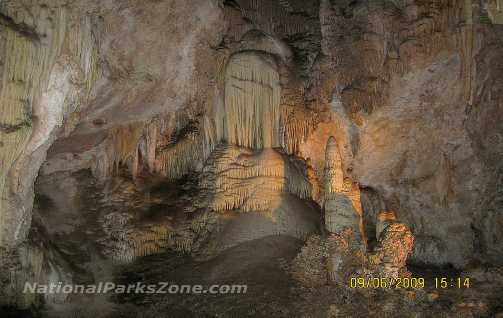Copyright © 2014-
All Rights Reserved

Updated 02/11/23 7:04 PM
Other Resources
Carlsbad Caverns National Park on the National Parks Service website -
Carlsbad Caverns National Park -
Carlsbad, New Mexico
Roswell, New Mexico -
Carlsbad Caverns National Park
Situated in New Mexico’s Guadalupe Mountains this is easily the most spectacular cavern in the national park system.
New Mexico
1970, 2009
About the Park
Carlsbad Caverns National Park, located near New Mexico's south eastern border, is formed out of the remains of a 250 million year old reef.
Mammoth Cave National Park in Kentucky may have a larger underground network than Carlsbad has but nowhere near the number of beautiful formations found in Carlsbad caverns.
The area surrounding Carlsbad Caverns was once part of a large inland sea. Over millions of years the limestone Capitan Reef formed. Underneath it was a large petroleum reserve from which hydrogen sulfide percolated up and combined with the oxygen in groundwater to form sulfuric acid which carved out the caverns.
The Caverns are known for their famous Bat Flight Program which takes place nightly at the amphitheater at the natural entrance to the Caverns. Every evening at dusk between 500,000 and 1 million bats spiral up into the sky and head over towards the Pecos River to feast on the insects. You take your seat and the Rangers tell you about what you are about to see and at some point you start to see bats exiting the cave. The numbers continue to build and you hear the flapping of their wings as they form a dark cloud stretching up from the entrance.
It is quite a sight but unfortunately it was a windless, humid night and I found the smell of ammonia from all the bat guano to be a bit much and was starting to overwhelm me. Once the bats left I couldn’t get out of the amphitheater area fast enough.
The first time I was at Carlsbad Caverns was in 1970 and I recall the Rangers telling us that early in the century some people thought that, given the number of bats in the cave, there should be plenty of bat guano. California’s fruit and vegetable industry was ramping up and there was a need for high nitrate fertilizer which bat guano was. Sure enough they found that there was plenty of bat guano -
You can enter Carlsbad Caverns either through the natural entrance or you can take an elevator 750 feet down to the aptly named Big Room. The Big Room, which is almost 4,000 feet long, 625 feet wide, and 255 feet high at its highest point (1,220 m X 191 m X 78 m) is where most people visiting the caverns spend their time. It is almost 8 acres in area. The paved walk is over a mile and winds in and out of various formations with names like the Totem Pole, the Bottomless Pit, Iceberg Rock, the Temple of the Sun, the Witch’s Finger and the Rock of Ages. There is also a shortcut that can cut the walk in half.
Along with the usual stalactites and stalagmites there are other unusual features with names like soda straws, popcorn, cave pearls, draperies and columns.
There’s about two dozen other ‘rooms’ with names like the New Mexico Room, the Papoose Room and the Green Lake Room. Some of these can be seen by taking various tours given by the park service. The tour descriptions should be carefully scrutinized because some of them will involve contact with water, crawling through tight spots and ladders and are best left to those who are fit and adventurous.
You can, instead of taking the elevator down to the Big Room, hike in through the natural entrance. It’s a steep descent of about 1 ¼ miles. When I was first at the caverns in 1970 hiking in required a Ranger guide and I recall a longer hike down to the Big Room. I also recall walking along ledges and having the lights go out which left us in total blackness. The Rangers had flashlights and told everybody to just stay put and the lights would come back on which they did. In 2009 we just were able to hike the trail down to the Big Room on our own. I believe they have simplified matters in the intervening years.
There are 119 other caves in the park but only three are open for park tours. Carlsbad Caverns is the only one with paved walkways and lights.
The temperature in the Caverns is a year-
Wildlife
Along with 17 different species of bats there’s the usual assortment of desert wildlife: snakes and lizards, reptiles and amphibians. The mammals include coyotes, foxes, wolves, bobcats, mountain lions, Rocky Mountain elk, pronghorn, black bears, javelinas, skunks, porcupines, pikas, hares, rabbits, weasels, otters and badgers. Over 300 species of birds have been seen in the park.
Lodging
There is no lodge in the park. The town of Carlsbad, New Mexico has ample lodging options and is about 24 miles to the park’s visitor center. There are also somewhat more limited options in White City, NM which is only about 4 miles from the park.
Hiking
For most visitors the hiking involves walking around the Big Room or on some other cave tour.
There are hiking options where you can experience the Chihuahuan desert scenery.
Walnut Canyon Trail
This is a 5-
Chihuahuan Desert Nature Trail
This is a paved ½ mile walkway.
Juniper Ridge Trail
The Juniper Ridge trail is considered easy with an 800 foot (240 m) change in elevation over the 3.5 mile (5 km) path.
Lower Rattlesnake Canyon
This is considered a moderate trail with an elevation change of 600 feet over the 3 mile length.
Old Guano Road Trail
This follows a road used to haul guano in the early 1900’s and mining debris is present along the way. It is 3.7 miles and has a750 foot elevation change.
The NPS website has a long list of what you need to know and bring on a desert hike – especially in the Summer. This link on the National Park’s Service website for Carlsbad Caverns National Park is for surface hikes and contains that information as well as links to trail descriptions.
Other Points of Interest
Roswell, New Mexico
The town of Roswell is about 75 miles north of Carlsbad and is associated with the famous 1947 UFO incident. Starting in the 1970’s conspiracy theories made their way into popular culture concerning an alien spacecraft crash, government cover-
The town has traded on that event and has alien-
Carlsbad Caverns National Park Photo Gallery

Other National Parks Within a Day’s Drive:
Guadalupe Mountains National Park is only about 35 miles south of Carlsbad Caverns National Park. It is a short, easy drive that can leave you with plenty of time to hike and get the feel of the park.
White Sands National Park has miles of pure white gypsum sand dunes. It is about 150 miles away from Carlsbad and a longer but worthwhile day trip.
Big Bend National Park has the Chisos Mountains and Chihuahuan desert. It is about 280 miles south of Carlsbad and about a 5 hour drive. Big Bend is a terrific park that won’t disappoint.
*N*P*Z*

National Parks Zone